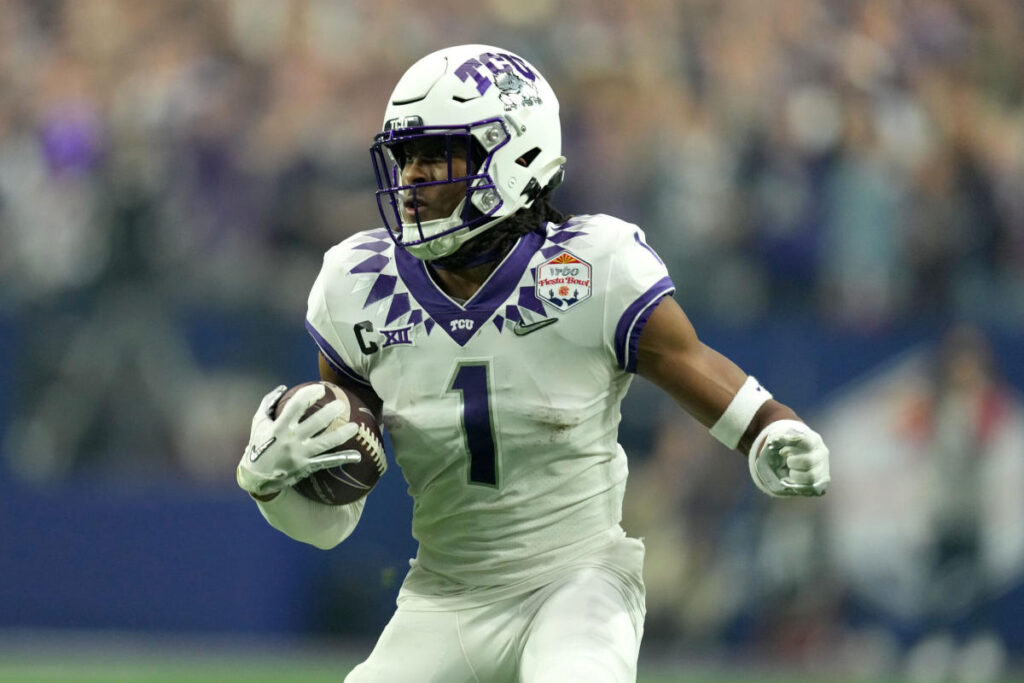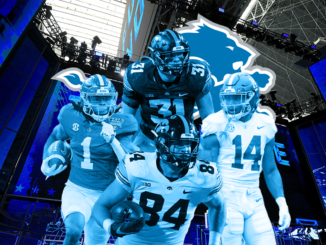This year’s wide receiver class is certainly intriguing. What it lacks in true star power at the top, it more than makes up for with phenomenal depth, with players well into day two who can be plus contributors at the NFL level. Here are my top ten wide receivers in the 2023 NFL Draft.
You can also download our free 2023 NFL Draft Guide, with over 130 in-depth prospect profiles!
1. Quentin Johnston, TCU (6-3, 208, Junior)

Pros: Johnston possesses the ideal blend of size and speed. He excelled in an X receiver role for TCU, showing the ability to win at all three levels of the field. His release package is excellent too and he has shown that he is capable of beating press coverage and getting out into his routes. Perhaps Johnston’s best trait though is his dynamism after the catch. He is remarkably twitchy and sudden for a bigger receiver and will routinely make opponents miss in space. He forced 44 missed tackles on his 114 career receptions.
Cons: Johnston remains noticeably raw as a route runner and was tasked with running a very basic route tree during his time at TCU. It remains to be seen how he handles a more varied role at the NFL level. There are also some very real concerns about his hands. Despite his size, Johnston does not cope well in contested situations. He also has a frustrating tendency to body catch and looks uncomfortable when asked to work outside his frame.
Projection: 1st round
2. Jaxon Smith-Njigba, Ohio State (6-0, 196, Junior)

Pros: Smith-Njigba displays the route running smarts of an NFL veteran. He is a smooth mover in and out of his breaks and understands how to subtly vary his routes to create separation. He also has an innate understanding of how to locate space when working against zone coverage. His hands are amongst the best in the class and he looks comfortable when asked to play through contact. Smith-Njigba is also incredibly dynamic after the catch, forcing 20 missed tackles on 109 career receptions.
Cons: Perhaps the biggest knock on Smith-Njigba is that his production has come almost entirely from the slot. He has just 88 career snaps as a boundary receiver and even fewer against press coverage. This, coupled with his lack of length, will lead to questions as to whether he is a slot-only receiver at the NFL level. He also lacks ideal long speed and struggles to separate on vertical routes. Smith-Njigba has just one season of collegiate production to his name.
Projection: 1st round
3. Jonathan Mingo, Ole Miss (6-2, 220, Senior)

Pros: Mingo is one of the biggest receivers in the class and has the play strength to match. He shows good physicality throughout the route to fight off contact and tracks the ball very well downfield to haul in the football. He is a legitimate athlete too, with both the quickness to separate in short areas and the long speed to stack defenders on the vertical tree. His combination of size and speed also makes him a weapon after the catch. Mingo is also one of the best perimeter blockers in this class.
Cons: Whilst Mingo is explosive, he isn’t the most fluid receiver in and out of his breaks. There are also concerns about his route running ability. Whilst he certainly showed signs of promise in that regard, he only ever ran a pretty basic route tree at Ole Miss. Despite his size he isn’t as dominant as you might expect in contested situations. Mingo also didn’t have a single season in college where he led his team in catches or receiving yards.
Projection: 1st round
4. Zay Flowers, Boston College (5-9, 182, Senior)

Pros: Flowers is a good athlete who also ticks the box when it comes to his route running ability. He is a smooth and technically refined receiver who understands how to manipulate defensive backs and create separation downfield. Defenses will have to account for his long speed as a vertical threat, but he is also one of the most dynamic YAC threats in this year’s class, with 40 forced missed tackles on 199 receptions. Whilst he isn’t the biggest receiver, Flowers plays bigger than his listed size.
Cons: Flowers spent most of his college career as a boundary receiver, but it is difficult to see how that translates to the NFL. He struggled with more physical defensive backs at the line of scrimmage and this, coupled with his small frame, means that he is likely going to see most of his work out of the slot in future. Flowers also showed inconsistent hands with a few too many drops on his tape. His small frame also means he is working with a limited catch radius.
Projection: 1st round
5. Josh Downs, UNC (5-9, 171, Junior)

Pros: Downs is a tremendously explosive athlete who creates easy separation through his routes. He is a very fluid mover in space, with great sink in his hips at the top of his routes. He pairs this with lightning fast feet to throttle down at a moment’s notice. Despite being a smaller receiver, Downs has some of the best hands in the class and plays far bigger at the catch point than you might expect. He has also been one of the most productive collegiate receivers since becoming a starter for UNC.
Cons: Size is going to be the biggest concern with Downs. At 5’9″ and 171 lbs he is small even by slot receiver standards. He is predictably lacking in play strength throughout the route and there will be worries about how well he can hold up against NFL cornerbacks. Downs also has a limited catch radius and looked less comfortable when asked to work outside his frame. He also played almost exclusively from the slot in college.
Projection: 2nd round
6. Marvin Mims, Oklahoma (5-11, 183, Junior)

Pros: Mims is a true speedster who will be a legitimate deep threat in the NFL from day one. He has the explosiveness to quickly stack corners and the long speed to separate downfield, as evidenced by his 19.5 yards per catch average throughout his career. Mims also possesses some of the best hands in the class, with outstanding ball tracking to haul the ball in over his shoulder. Despite not being the biggest receiver, Mims shows good toughness at the catch point to play above his size.
Cons: Mims lacks ideal size to translate to the NFL, particularly for a player that spent a good proportion of their college career working on the boundary. He may be limited to a slot-only role at the next level as a result. He also ran a fairly limited route tree at Oklahoma and doesn’t show much nuance to his game at this point. Whilst he is solid enough as a YAC threat, he doesn’t have the dynamism in the open field that you might expect for a player of his size and speed.
Projection: 2nd round
7. Cedric Tillman, Tennessee (6-3, 213, rs-Senior)

Pros: Tillman showcases some of the best hands in this year’s draft class and pairs this with a huge catch radius. Throughout his career at Tennessee he logged just five drops on 114 career catchable targets. He also possesses a strong blend of size and athleticism, with the long speed to threaten defenses on the vertical tree. It is also noteworthy that Tillman’s best performances came against top competition, with over 150 yards against Alabama and a 200 yard game against Georgia.
Cons: Tillman is more of a straight line athlete and he didn’t look nearly as effective when asked to sink his hips and quickly change direction. He is also reliant on the use of hands at the top of the route to create separation, something that may not be as effective against bigger cornerbacks in the NFL. There are also some injury concerns – Tillman played through an ankle injury in 2022 and didn’t look nearly as dominant as he had in 2021. He needs to show he can get back to full fitness and recapture that form.
Projection: 2nd round
8. Jordan Addison, USC (5-11, 173, Junior)

Pros: Addison is a very well-rounded route runner, with the smooth hips and easy change of direction ability to create separation out of his breaks. He is a smart player too, who shows the ability to use subtle body and head fakes to manipulate defensive backs and create throwing windows. He showcases sufficient long speed to be a true three-level threat that can beat defenses over the top. Addison also possesses some of the more reliable hands in the class, with a 3.3% drop rate in 2022.
Cons: Addison’s size is a legitimate concern and he would benefit significantly from adding extra muscle mass. There aren’t many NFL receivers who are succeeding in high volume roles at less than 175 lbs. He split his time in college between the boundary and the slot but he struggled with physicality at the line of scrimmage and he might be a slot-only receiver in the NFL. His skinny frame also limited his ability to consistently play through traffic at the catch point.
Projection: 2nd round
9. Michael Wilson, Stanford (6-2, 213, rs-Senior)

Pros: Wilson possesses an ideal combination of size and movement skills, with the silky footwork and route running refinement that translate well to the NFL level. His release package is perhaps the best in the entire class and this, paired with his intelligent route running, allows him to create consistent separation. His size is ideal for an X receiver role at the NFL level and he should have no problem holding up to the physicality of the pro game. He also showed the ability to create his own yardage after the catch.
Cons: Wilson comes with some significant injury concerns. This has hampered his ability to produce consistently in college and he hasn’t played more than six games in a season since way back in 2019. This was the only time in his career that he exceeded 50 catches and 500 yards. Wilson lacks ideal long speed to threaten defenses over the top, running a 4.56 in the 40-yard dash. He also had a few too many concentration drops on tape.
Projection: 2nd round
10. Tank Dell, Houston (5-8, 165, rs-Senior)

Pros: Dell is the king of separation and seemed to be consistently open for Houston. He is incredibly shifty in short areas, leaving defenders flat footed at the top of his routes. He pairs this with an innate understanding of route running and you will regularly see him set up and manipulate defenders. Dell is also an incredibly dynamic player with the ball in his hands, logging 38 forced missed tackles on 199 catches over the past two seasons. He also adds value as a kick returner.
Cons: The most obvious question mark with Dell is his size. At 5’8″ he ranks in just the third percentile for height amongst NFL receivers. At 165 lbs he is in the first percentile for weight. Both would clearly make him a major outlier from an NFL wide receiver perspective. Unsurprisingly he struggles to play through contact at the catch point and will be bullied through the route by bigger cornerbacks. Dell also had some issues with focus drops throughout his college career.
Projection: 3rd round


